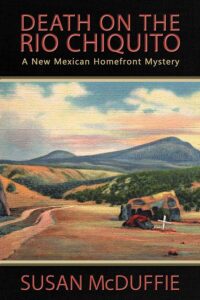
Death on the Rio Chiquito

Miss Marple meets Tony Hillerman in WWII New Mexico
New Mexico, 1943: Emily Schwarz, the Anglo teacher at the isolated Pueblo of San Antonito, discovers the corpse of a nineteen-year-old boy, his blood mingling with the muddy waters of the tiny Rio Chiquito. Who shot Juan? His cousin? A jealous girlfriend? Emily’s good friend then vanishes, followed by the disappearance of Juan’s little brother. Aided by Gregorio Cruz, the tribal sheriff, and by the mysterious Mr. Shepherd, Emily’s quest for truth leads to small Hispanic towns, Native American villages, and Bohemian Santa Fe. The search ultimately endangers her own life, and the investigation broadens. Is this a local killing, or could wartime secrets be at risk in this sleepy backwater?
Read an Excerpt
Chapter 1
Emily Wilson Schwarz closed the door of the school building behind her. She took a deep breath of the hot dry afternoon air, smelling the sweet vanilla scent of the ponderosa pines on the mesa that mingled with the pungent scent of horses from the village corrals. Eager to stretch her legs, Emily left the brick San Antonito Pueblo Day School and headed away from the village, toward the fields that bordered the Rio Chiquito, a tiny tributary of the Rio Grande.
A large cottonwood stood close to the river. Emily headed towards it, striding along the border of the alfalfa field, her eyes hungry for anything green, her ears thirsty for the sound of water. It had been a dry year so far. Overhead some buzzards circled, their large wings black against the deep blue sky. Emily shrugged, wondering what they had found.
Nearby she saw Hilario Mondragon hard at work, lifting the gate on one of the acequias, the irrigation ditches that led to the fields and provided water for the crops. Hilario’s corn looked almost ready to harvest. Above, reddish black cliffs towered up to the mesa tops on either side of the narrow valley.
Emily waved at Hilario, who gestured back. Emily taught three of Hilario’s children at the day school. One older daughter was at the boarding school in Santa Fe; the oldest son, Nasario, had enlisted and was serving someplace in the Pacific, fighting.
Emily had been at San Antonito three years now, long enough to settle into teaching at the day school, run by the Federal United Pueblo Association in Albuquerque. Since her arrival, at age twenty-nine, war had broken out. The attack on Pearl Harbor, nearly two years ago now, had changed everything. Emily’s brother Tom fought in the Pacific theater, and she constantly worried for him. She wondered if Tom and Nasario were stationed in the same unit, over there on the other side of the world.
Aside from the village boys in the service, and rationing cards for groceries and gas, life in the little Indian pueblo of San Antonito seemed remarkably unchanged by the war. Not like Racine. On her last visit home earlier in the summer, her mother had been sick with worry over Tom, and every night her dad drank far too many bourbons as he listened to the war news on the radio. It had been a relief to leave them both and come back to her job in New Mexico, teaching the five-to-twelve-year-olds during the day, and leading some adult education classes in health and home economics in the evenings. Canning and sewing classes proved popular with the ladies.
The women of San Antonito did their part for the war effort, knitting wool socks for the troops. People took them up to the Red Cross in Santa Fe when they went into town for supplies. Emily had also helped the tribal officials organize a scrap drive, and folks had ransacked their barns and sheds for old tires and metal; they had managed to get over five hundred pounds of material.
San Antonito didn’t yet have any electricity, so copies of the Santa Fe New Mexican folks bought from Romero’s grocery in the village provided the only war news. Creased and wrinkled copies of the newspaper got passed around from house to house. Although the fighting sometimes seemed very far away, the community had been touched by it. Mothers worried for their sons everywhere, Emily thought, in Racine, and in little San Antonito.
The buzzards still circled, and Emily watched them swoop down on something near the big cottonwood. Probably a rabbit, she thought, but decided to go take a closer look. She could do with a little more exercise. There weren’t any adult classes later on, and she was looking forward to a quiet evening, a sandwich, a cup of coffee, and maybe a novel. She had Daphne du Maurier’s latest, Hungry Hill, which she had picked up while in Racine.
As Emily approached the tree the buzzards flew back into the sky with a rush, but kept on circling. Emily felt their eyes on her, watching from above. She shuddered and took a deep breath, catching a whiff of something on the breeze. Something dead. More than a rabbit. Coyote? A dog?
The ancient cottonwood grew next to the Rio Chiquito, its massive roots emerging from the undergrowth of salt cedar and Russian olive trees to seek water from the riverbed. Emily pushed her way through the scrub, down to the bank of the stream, not seeing any sign of a rabbit or coyote. Then she stopped short.
A body lay sprawled amid the roots of the cottonwood, partly in the river. Almost as though whoever it was had tripped and fallen into the water.
Emily went over and knelt, her heart racing, and gently touched the body. As soon as she felt the young man’s cold, inert form she knew there was no chance.
Beneath the brown skin she saw the bluish pallor of death. A splash of dark red stained the man’s chest, oddly displaced against the white shirt like some young child’s angry watercolor. The clotted blood seeped from the wound and mixed with the waters of the Rio Chiquito, a red trail flowing down the current towards the Rio Grande.
Her gaze went to the dead man’s face, and Emily belatedly recognized the corpse. It was Juan, the older son of Atencio Montoya, the governor of the pueblo.
Praise for Death on the Rio Chiquito
“Susan McDuffie’s skillful, descriptive writing adds layers of depth to a compelling tale of murderous evil at a Pueblo Indian village filled with old grievances and tightly held affection. The historical setting—New Mexico at the dawn of the atomic age—adds to the likeable protagonist’s challenges. McDuffie, a first-rate storyteller, sets the scene with such care that readers can smell the coffee and taste the homemade tortillas. The crime-solving schoolteacher uses her curiosity and persistence to get to the bottom of several shocking deaths and the kidnapping of a friend and a child. This could be the start of a fine series of mysteries.”
Anne Hillerman, best-selling author of the Leaphorn, Chee, Manuelito mysteries
QUICK LINKS

Medieval Mysteries
A Mass for the Dead
The Faerie Hills
The Death of a Falcon
A Study of Murder
The Suicide Skull

